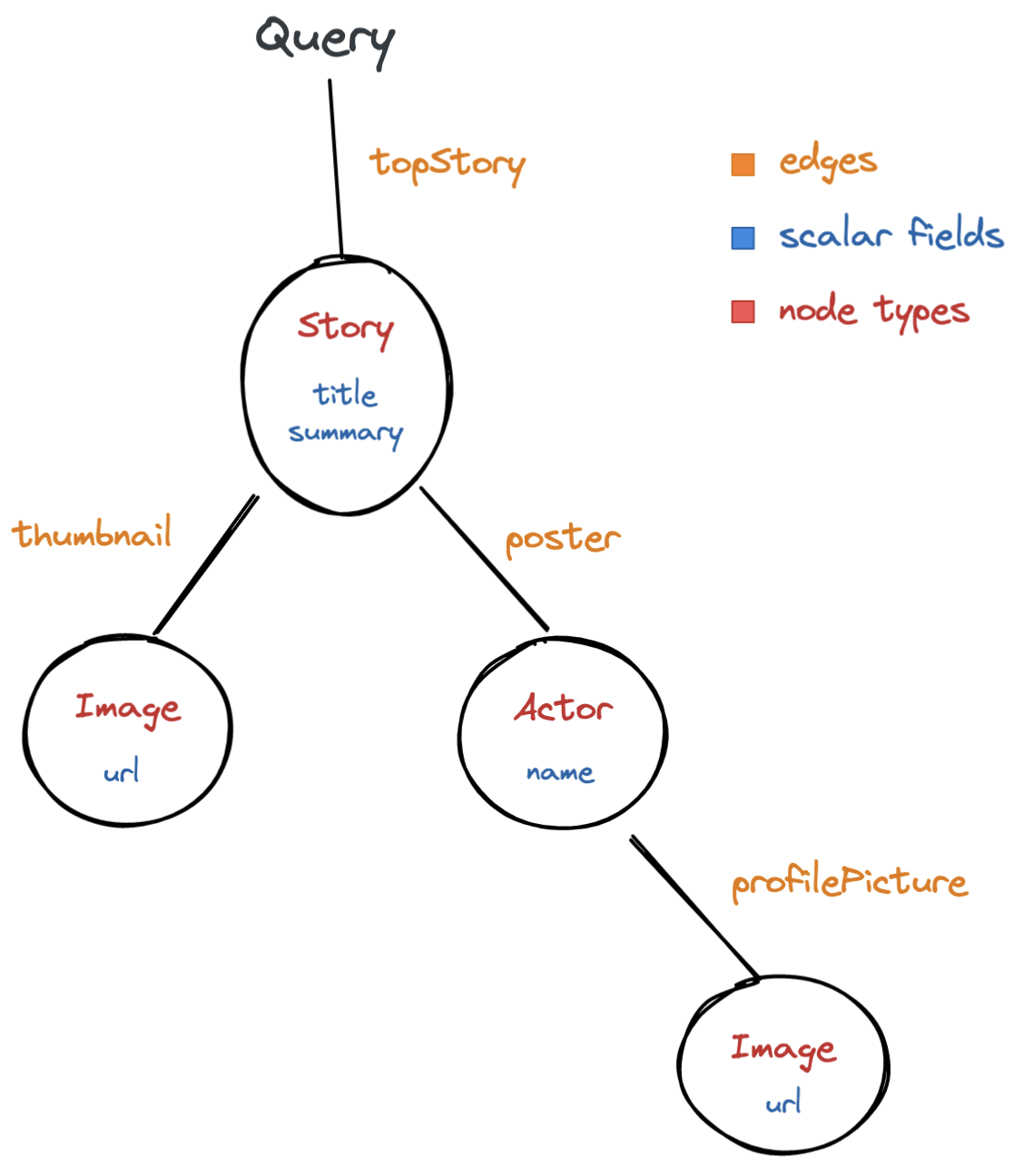Query Basics
In this section:
- We’ll take a React component that displays hard-coded placeholder data and modify it so that it fetches its data using a GraphQL query.
- We’ll learn how to use the TypeScript types that Relay generates from your GraphQL to ensure type safety.
With Relay, you fetch data using GraphQL Queries. A Query specifies a part of the GraphQL graph for your app to fetch, starting from some root node and traversing from node to node to retrieve a particular set of data in the shape of a tree.

Right now, our example app doesn’t fetch any data, it just renders some placeholder data that’s hard-coded into the React components. Let’s modify it to fetch some data using Relay.
Open up the file called Newsfeed.tsx. (All of the components in the tutorial are in src/components.) In it you should see a <Newsfeed> component where the data is hard-coded:
export default function Newsfeed() {
const story = {
title: "Placeholder Story",
summary:
"Placeholder data, to be replaced with data fetched via GraphQL",
poster: {
name: "Placeholder Person",
profilePicture: {
url: "/assets/cat_avatar.png",
},
},
thumbnail: {
url: "/assets/placeholder.jpeg",
},
};
return (
<div className="newsfeed">
<Story story={story} />
</div>
);
}
We’re going to replace this placeholder data with data fetched from the server. First we need to define a GraphQL query. Add the following declaration above the Newsfeed component:
import { graphql } from 'relay-runtime';
const NewsfeedQuery = graphql`
query NewsfeedQuery {
topStory {
title
summary
poster {
name
profilePicture {
url
}
}
thumbnail {
url
}
}
}
`;
Let’s break this down:
- To embed GraphQL within Javascript, we put a string literal marked with the
graphql``tag. This tag allows the Relay compiler to find and compile the GraphQL within a Javascript codebase. - Our GraphQL string consists of a query declaration with the keyword
queryand then a query name. - Inside the query declaration are fields, which specify what information to query for*:*
- Some fields are scalar fields that retrieve a string, number, or other unit of information.
- Other fields are edges that let us traverse from one node in the graph to another. When a field is an edge, it’s followed by another block
{ }containing fields for the node at the other end of the edge. Here, theposterfield is an edge that goes from a Story to a Person who posted it. Once we’ve traversed to the Person, we can include fields about the Person such as theirname.
This illustrates the part of the graph that this query is asking for:

Now that we’ve defined the query, we need to modify our React component to fetch it and to use the data returned by the server.
Turn back to the Newsfeed component and start by deleting the placeholder data. Then replace it with this:
import { useLazyLoadQuery } from "react-relay";
export default function Newsfeed({}) {
const data = useLazyLoadQuery(
NewsfeedQuery,
{},
);
const story = data.topStory;
// As before:
return (
<div className="newsfeed">
<Story story={story} />
</div>
);
}
The useLazyLoadQuery hook fetches and returns the data. It takes two arguments:
- The GraphQL query that we defined before.
- Variables that are passed to the server with the query. This query doesn’t declare any variables, so it’s an empty object.
The object that useLazyLoadQuery returns has the same shape as the query. For instance, if printed in JSON format it might look like this:
{
topStory: {
title: "Local Yak Named Yak of the Year",
summary: "The annual Yak of the Year awards ceremony ...",
poster: {
name: "Baller Bovine Board",
profilePicture: {
url: '/images/baller_bovine_board.jpg',
},
},
thumbnail: {
url: '/images/max_the_yak.jpg',
}
}
}
Notice that each field selected by the GraphQL query corresponds to a property in the JSON response.
To see the result, we first need to address an error that TypeScript reports with this code as we’ve written it:
const story = data.topStory;
^^^^^^^^
Property 'topStory' does not exist on type 'unknown'
To fix this, we need to annotate the call to useLazyLoadQuery with types that Relay generates. That way, TypeScript will know what type data should have based on the fields we’ve selected in our query. Add the following:
import type {NewsfeedQuery as NewsfeedQueryType} from './__generated__/NewsfeedQuery.graphql';
function Newsfeed({}) {
const data = useLazyLoadQuery
<NewsfeedQueryType>
(NewsfeedQuery, {});
...
}
At this point, you should see a story fetched from the server:

The server's responses are artifically slowed down to make loading states perceptible, which will come in handy when we add more interactivity to the app. If you want to remove the delay, open server/index.js and remove the call to sleep().
The useLazyLoadQuery hook fetches the data when the component is first rendered. Relay also has APIs for pre-fetching the data before your app has even loaded — these are covered later. In any case, Relay uses Suspense to show a loading indicator until the data is available.
This is Relay in its most basic form: fetching the results of a GraphQL query when a component is rendered. As the tutorial progresses, we’ll see how Relay’s features fit together to make your app more maintainable — starting with a look at how Relay generates TypeScript types corresponding to each query.
Deep dive: Suspense for Data Loading
Suspense is a new API in React that lets React wait while data is loaded before it renders components that need that data. When a component needs to load data before rendering, React shows a loading indicator. You control the loading indicator's location and style using a special component called Suspense.
Right now, there's a Suspense component inside App.tsx, which is what shows the spinner while useLazyLoadQuery is loading data.
We'll look at Suspense in more detail in later sections when we add some more interactivity to the app.
Deep dive: Queries are Static
All of the GraphQL strings in a Relay app are pre-processed by the Relay compiler and removed from the resulting bundled code. This means you can’t construct GraphQL queries at runtime — they have to be static string literals so that they’re known at compile time. But it comes with major advantages.
First, it allows Relay to generate type definitions for the results of the query, making your code more type-safe.
Second, Relay replaces the GraphQL string literal with an object that tells Relay what to do. This is much faster than using the GraphQL strings directly at runtime.
Also, Relay’s compiler can be configured to save queries to the server when you build your app, so that at runtime the client need only send a query ID instead of the query itself. This saves bundle size and network bandwidth, and can prevent attackers from writing malicious queries since only those your app was built with need be available.
So when you have a GraphQL tagged string literal in your program...
const MyQuery = graphql`
query MyQuery {
viewer {
name
}
}
`;
... the Javascript variable MyQuery is actually assigned to an object that looks something like this:
const MyQuery = {
kind: "query",
selections: [
{
name: "viewer",
kind: "LinkedField",
selections: [
name: "name",
kind: "ScalarField",
],
}
]
};
along with various other properties and information. These data structures are carefully designed to allow the JIT to run Relay’s payload processing code very quickly. If you’re curious, you can use the Relay Compiler Explorer to play with it.
Deep dive: Relay and the Type System
To fix the TypeScript error we had to import a file that we did not create ourselves: __generated__/NewsfeedQuery.graphql. What's in this file?
If we look inside it, we’ll see the following type definition — with the annotation we’ve just added, TypeScript knows that data should have this type:
export type NewsfeedQuery$data = {
readonly topStory: {
readonly poster: {
readonly name: string | null;
readonly profilePicture: {
readonly url: string;
} | null;
};
readonly summary: string | null;
readonly thumbnail: {
readonly url: string;
} | null;
readonly title: string;
} | null;
};
The Relay compiler generates TypeScript types corresponding to every piece of GraphQL that you have in your app within a graphql`` literal. As long as npm run dev is running, the Relay compiler will automatically regenerate these files whenever you save one of your JavaScript source files, so you don’t need to refresh anything to keep them up to date.
Using Relay’s generated types makes your app safer and more maintainable. In addition to TypeScript, Relay supports the Flow type system if you want to use that instead. When using Flow, the extra annotation on useLazyLoadQuery is not needed, because Flow directly understands the contents of the graphql`` tagged literal.
We’ll revisit types throughout this tutorial.
Summary
Queries are the foundation of fetching GraphQL data. We’ve seen:
- How to define a GraphQL query within our app using the
graphql``tagged literal - How to use the
useLazyLoadQueryhook to fetch the results of a query when a component renders. - How to import Relay's generated types for type safety.
In the next section, we’ll look at Fragments, one of the most core and distinctive aspects of Relay. Fragments let each individual component define its own data requirements, while retaining the performance advantages of issuing a single query to the server.